Lenovo Ideapad 320s (15-inch) review – Lenovo’s cheap but well-balanced and elegant everyday solution

Premium feel, budget price. That’s the best way to describe the 15-inch Ideapad 320s, which quite frankly, makes the standard Ideapad 320 obsolete. Although the latter offers decent hardware for the asking price, the 320s raises the bar with super thin screen bezels, aluminum lid, better input devices, lower weight, thinner profile and overall better feel and user experience.
But what about battery, screen quality and thermals? Even if the Ideapad 320s doesn’t really impress with endurance and won’t be able to drive all the demanding games nowadays, the IPS screen on this sub-$600 laptop makes it one of the most affordable and sensible multimedia choices out there. We are still waiting for the hardware refresh with Intel’s latest 8th Generation processors and NVIDIA’s budget GeForce MX150 graphics chip so it can go head to head with Acer’s Aspire 5 (A515-51G), which is the closest you can get to an affordable true multimedia laptop. Let’s find out what else the Ideapad 320s has in stored for us.
Contents
- Retail package
- Design and construction
- Disassembly, maintenance and upgrade options
- Display quality
- PWM (Screen flickering)
- Buy our display profiles
- Sound
- Specs sheet
- Lenovo Ideapad 320s configurations
- Software
- Battery
- CPU – Intel Core i5-7200U
- GPU – NVIDIA GeForce 940MX (2GB GDDR5)
- Gaming tests
- Temperatures
- Verdict
Retail package
The laptop comes in a standard package containing all of the usual user manuals and AC adapter for charging.
Design and construction
Visually, the Ideapad 320s isn’t much different from the Ideapad 320 but it once you touch it, you will feel the difference. The Ideapad 320s feels slightly lighter, smaller but somehow more robust at the same time. Measuring at just 19.9 mm in thickness and weighing less than 2 kg (1.9 kg to be exact), the Ideapad 320s is one of the most portable 15-inch laptops in its class.
The lid is the only element that’s made of anodized aluminum and interestingly enough, the metal sheet feels pretty thick and stable. We’ve reviewed much more expensive notebooks with aluminum lids but noticeable flex. Here, on the other hand, the flex is almost non-existent. Also, the dark gray color variant that we are reviewing isn’t susceptible to fingerprints and smudges. Anyway, as you open the lid, you will notice the exceptionally thin side bezels while the upper one is slightly thicker so the webcam can fit in. This has significantly reduced the footprint of the case. You will also feel that the hinge keeps the lid firmly in place but it’s a challenge to open it. Using one hand is impossible as well. The bottom piece is made of plastic and offers a big vent that helps with the cooling and two smaller ones for the speakers.
Going around the sides, we see pretty much all the connectors and ports that you’d probably need. On the left, you will find most of them making the right side clear of the cables, which is a good thing. The DC charging port, HDMI, USB 3.0, USB-C 3.1 (Gen 1) and the 3.5 mm audio jack are on the left while on the right, you will see the standard USB 2.0 and an SD card reader. Probably another USB 3.0 wouldn’t have hurt but let’s not get too picky.
The interior has that smooth plastic finish strongly imitating aluminum but once you press the wrist rest area and the spot between the clickpad and the spacebar, you will know it’s not. A visible flex occurs that shouldn’t reflect on one’s usage but we feel that it should be noted. In any case, we were delighted by the input devices – the keyboard is super nice with reasonable key travel, tactile and clicky feedback and a pretty standard layout that will ensure quick adaptation. The touchpad, however, was a big surprise here. It’s extra smooth, it offers exceptionally light mouse clicks and good and accurate response. It pretty much beats almost everything we’ve tried in this price range.
The bottom line is – the Ideapad 320s (15-inch) delivers way above average build quality for the asking price – with the small exception of the flexible wrist rest area, of course – while keeping low weight, compact dimensions and excellent input devices.
Disassembly, maintenance and upgrade options
The disassembly process is pretty easy and requires only the removal of the bottom screws. Then just gently pry up the bottom piece and you are set. Also, it seems that the Ideapad 320s is almost identical to the Ideapad 520s in terms of space management and internal design.
Storage upgrades – 2.5-inch HDD/SSD, M.2 SSD
Luckily, the Ideapad 320s has the usual storage configuration as most 15-inch laptops nowadays, even in the mid-range segment. Here we have the standard 2.5-inch HDD/SSD bay and an M.2 SSD slot as well. Our unit, however, came with one Seagate 1TB HDD.
| Slot | Unit | Upgrade price |
|---|---|---|
| M.2 SSD 2280 slot 1 | Free | Buy from Amazon.com (#CommissionsEarned) |
| 2.5-inch HDD/SSD slot | 1TB Seagate HDD | Buy from Amazon.com (#CommissionsEarned) |
RAM
The laptop comes with just one upgradeable memory slot which may not be enough for some users but for most, it should be an overkill. Since the device is going to be used mainly for multimedia, office work and web browsing, a maximum of 16GB of DDR4-2400 is more than enough. The unit we’ve tested, however, was equipped with an 8GB Samsung chip.
Other components
You will find the Qualcomm Atheros QCA9377 Wi-Fi adapter near the screen hinge.
The battery unit is located under the wrist rest area and takes a good chunk of the internal space. It’s rated at 52.5Wh.
Cooling system
The cooling system consists of a single heatpipe going across both heatsinks and one fan pushing the hot air out.
Display quality
The laptop features a Full HD (1920×1080) IPS display with 142 ppi and 0.18 x 0.18 mm pixel pitch. It’s manufactured by Innolux with model number N156HCA-EAA (CMN15E5). It can be considered as “Retina” at least from 69 cm.
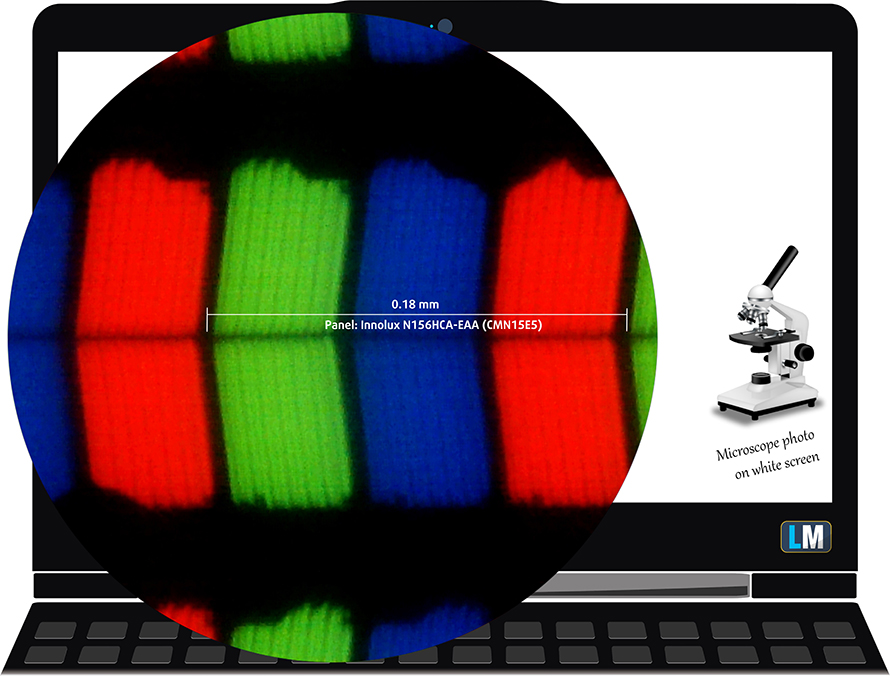
Viewing angles are excellent.

We’ve recorded a peak brightness of 239cd/m2 in the center of the screen and 229 cd/m2 as average across the surface with just 11% maximum deviation. The correlated color temperature at maximum brightness is almost optimal – 6510K and stays pretty much the same when going along the grayscale – 6550K. You can see how these values change at 140 cd/m2 (87% brightness) in the image below.
The maximum color deviation dE2000 compared to the center of the screen should be no more than 4.0 and if you are planning to do color-sensitive work, it should be lower than 2.0. And in this case, since the laptop is going to be used mostly for multimedia and gaming, a deviation of 3.5 in the upper left corner is negligible. The contrast ratio is 1360:1 before calibration and 1270:1 after calibration.

Color reproduction
To make sure we are on the same page, we would like to give you a little introduction of the sRGB color gamut and the Adobe RGB. To start, there’s the CIE 1976 Uniform Chromaticity Diagram that represents the visible specter of colors by the human eye, giving you a better perception of the color gamut coverage and the color accuracy.
Inside the black triangle, you will see the standard color gamut (sRGB) that is being used by millions of people in HDTV and on the web. As for the Adobe RGB, this is used in professional cameras, monitors etc for printing. Basically, colors inside the black triangle are used by everyone and this is the essential part of the color quality and color accuracy of a mainstream notebook.
Still, we’ve included other color spaces like the famous DCI-P3 standard used by movie studios, as well as the digital UHD Rec.2020 standard. Rec.2020, however, is still a thing of the future and it’s difficult for today’s displays to cover that well. We’ve also included the so-called Michael Pointer gamut, or Pointer’s gamut, which represents the colors that naturally occur around us every day.
As we’ve expected from a budget-oriented laptop like the Ideapad 320s, the IPS screen used for the configuration is in the lower-end spectrum. It covers just 53% of the sRGB color gamut meaning that it will be suitable only for general browsing and office work. The multimedia experience won’t be as good.
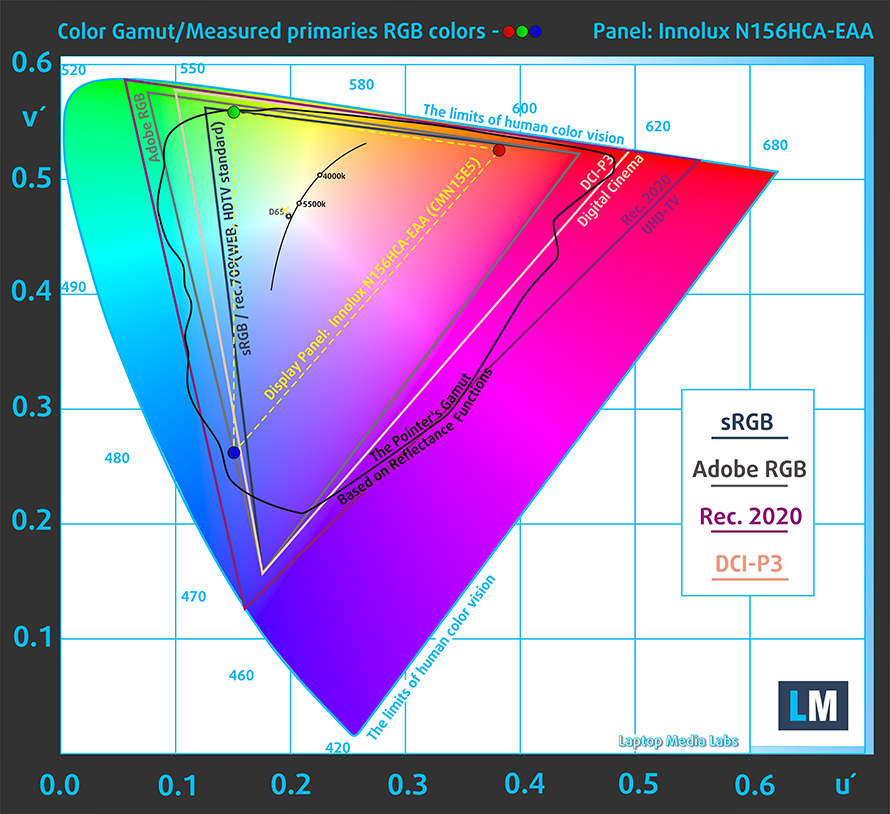
Our “Design and Gaming” profile delivers optimal color temperature (6500K) at 140 cd/m2 luminance and sRGB gamma mode.
We tested the accuracy of the display with 24 commonly used colors like light and dark human skin, blue sky, green grass, orange etc. You can check out the results at factory condition and also, with the “Design and Gaming” profile.
The next figure shows how well the display is able to reproduce really dark parts of an image, which is essential when watching movies or playing games in low ambient light.
The left side of the image represents the display with stock settings, while the right one is with the “Gaming and Web Design” profile activated. On the horizontal axis, you will find the grayscale and on the vertical axis – the luminance of the display. On the two graphs below you can easily check for yourself how your display handles the darkest nuances but keep in mind that this also depends on the settings of your current display, the calibration, the viewing angle and the surrounding light conditions.

Response time (Gaming capabilities)
We test the reaction time of the pixels with the usual “black-to-white” and “white-to-black” method from 10% to 90% and reverse.
We recorded Fall Time + Rise Time = 32 ms.

PWM (Screen flickering)
Pulse-width modulation (PWM) is an easy way to control monitor brightness. When you lower the brightness, the light intensity of the backlight is not lowered, but instead turned off and on by the electronics with a frequency indistinguishable to the human eye. In these light impulses, the light/no-light time ratio varies, while brightness remains unchanged, which is harmful to your eyes. You can read more about that in our dedicated article on PWM.
We’ve detected PWM only below 65 cd/m2 (around 68% brightness) but it’s also at pretty high frequency (26 kHz) so it’s practically safe to use at all brightness levels. However, we doubt that you will be using the display at 65 cd/m2 anyway.

Blue light emissions
Installing of our Health-Guard profile not only eliminates PWM but also reduces the harmful Blue Light emissions while keeping the colors of the screen perceptually accurate. If you’re not familiar with the Blue light, the TL;DR version is – emissions that negatively affect your eyes, skin and your whole body. You can find more information about that in our dedicated article on Blue Light.
You can see the levels of emitted blue light on the spectral power distribution (SPD) graph.
Conclusion
Obviously, the display has its noticeable drawbacks like limited sRGB coverage and low maximum brightness but it’s still a much better option than most notebooks with TN panels out there. In fact, this one surprises with excellent contrast ratio and no PWM above 68% brightness and both are essential for comfortable use.
Buy our display profiles
Since our profiles are tailored for each individual display model, this article and its respective profile package is meant for Lenovo Ideapad 320s configurations with 15.6″ Innolux N156HCA-EAA (CMN15E5) (FHD, 1920 × 1080) IPS screen and the laptop can be found at Amazon: Buy from Amazon.com (#CommissionsEarned)
*Should you have problems with downloading the purchased file, try using a different browser to open the link you’ll receive via e-mail. If the download target is a .php file instead of an archive, change the file extension to .zip or contact us at [email protected].
Read more about the profiles HERE.
In addition to receiving efficient and health-friendly profiles, by buying LaptopMedia's products you also support the development of our labs, where we test devices in order to produce the most objective reviews possible.

Office Work
Office Work should be used mostly by users who spend most of the time looking at pieces of text, tables or just surfing. This profile aims to deliver better distinctness and clarity by keeping a flat gamma curve (2.20), native color temperature and perceptually accurate colors.

Design and Gaming
This profile is aimed at designers who work with colors professionally, and for games and movies as well. Design and Gaming takes display panels to their limits, making them as accurate as possible in the sRGB IEC61966-2-1 standard for Web and HDTV, at white point D65.

Health-Guard
Health-Guard eliminates the harmful Pulse-Width Modulation (PWM) and reduces the negative Blue Light which affects our eyes and body. Since it’s custom tailored for every panel, it manages to keep the colors perceptually accurate. Health-Guard simulates paper so the pressure on the eyes is greatly reduced.
Get all 3 profiles with 33% discount
Sound
The sound quality of the loudspeakers is rather good with small distortions in the mid and lower spectrum of the frequencies.

Specs sheet
The current specs sheet is for this particular model and configurations may differ depending on your region
Lenovo Ideapad 320s (15-inch) technical specifications table
Lenovo Ideapad 320s configurations
Software
We used the pre-installed Windows 10 for the writing of this review but if you wish to perform a clean install of the OS, we suggest downloading all of the latest drivers from Lenovo’s official support page.
Battery
The battery results from our battery tests confirm what we’ve initially thought – the endurance is excellent. Thanks to the big 52.5Wh battery, the laptop is able to run away from the plug for quite some time. In fact, there’s little difference between the web browsing and video playback scores.
Of course, all tests were run using the same settings as always – Wi-Fi turned on, screen brightness set to 120 cd/m2 and Windows battery saving feature switched on.
In order to simulate real-life conditions, we used our own script for automatic web browsing through over 70 websites.
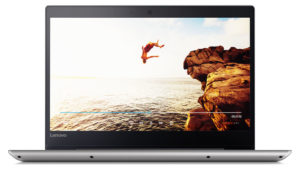



For every test like this, we use the same video in HD.




We use F1 2017’s built-in benchmark on loop in order to simulate real-life gaming.




CPU – Intel Core i5-7200U
 Intel’s Core i7-6200U is part of the 7th Generation Kaby Lake CPUs and it’s the direct successor of the Core i5-5200U (Broadwell) and Core i5-6200U (Skylake). It’s also based on the same architecture as the aforementioned chips with little differences that should bring a small performance increase and a bump in power consumption. However, the new CPU is clocked at 2.5 GHz and its Turbo Boost frequency is 3.1 GHz opposed to the 2.3 – 2.8 GHz clocks on the previous Core i5-6200U.
Intel’s Core i7-6200U is part of the 7th Generation Kaby Lake CPUs and it’s the direct successor of the Core i5-5200U (Broadwell) and Core i5-6200U (Skylake). It’s also based on the same architecture as the aforementioned chips with little differences that should bring a small performance increase and a bump in power consumption. However, the new CPU is clocked at 2.5 GHz and its Turbo Boost frequency is 3.1 GHz opposed to the 2.3 – 2.8 GHz clocks on the previous Core i5-6200U.
Anyway, we still have the 2/4 core/thread count, 3MB last level cache, and a TDP of 15W, which includes the iGPU and the dual-channel DDR4 memory controller. Speaking of the former, the chip integrates the newer generation Intel HD Graphics 620 graphics chip clocked at 300 – 1000 MHz.
You can browse through our top CPUs ranking: http://laptopmedia.com/top-laptop-cpu-ranking/
Here you will find other useful information and every notebook we’ve tested with this processor: http://laptopmedia.com/processor/intel-core-i5-7200u/
Results are from the Cinebench 20 CPU test (the higher the score, the better)
Results are from our Photoshop benchmark test (the lower the score, the better)
Results are from the Fritz chess benchmark (the higher the score, the better)
Fritz
Fritz is a chess benchmark that tests the computing capabilities of the CPU with various chess moves. The Intel Core i5-7200U scored 6.221 million moves per second. In comparison, one of the most powerful chess computers, Deep(er) Blue, was able to squeeze out 200 million moves per second. In 1997 Deep(er) Blue even beat the famous Garry Kasparov with 3.5 to 2.5.
GPU – NVIDIA GeForce 940MX (2GB GDDR5)
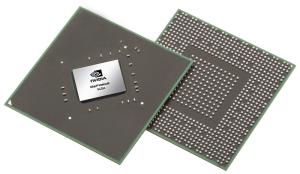 The NVIDIA GeForce 940MX is a refreshed version of the older 940M mobile chip but paired with a faster GDDR5 memory and slightly higher clock speeds, which result in noticeably better performance compared to the standard 940M. However, some OEMs will still choose to use the cheaper DDR3 version of the GPU.
The NVIDIA GeForce 940MX is a refreshed version of the older 940M mobile chip but paired with a faster GDDR5 memory and slightly higher clock speeds, which result in noticeably better performance compared to the standard 940M. However, some OEMs will still choose to use the cheaper DDR3 version of the GPU.
Announced back in the first quarter of 2016, the chip is almost identical to the standard 940M (Maxwell) but with clock speeds increased up to 1242 MHz and base 1122 MHz. Again, the memory uses a 64-bit bus and has 2GB of GDDR5 VRAM. It still supports the DirectX 12 API and Shader 5.0 feature along with the usual NVIDIA technologies – CUDA, GPU Boost 2.0, Optimus, GeForce Experience, PhysX. The whole GPU is rated at around 15 to 30 Watts depending on the clock speeds and memory used in the specific notebook.
You can browse our GPU ranking to see where the graphics chip stands: http://laptopmedia.com/top-laptop-graphics-ranking/
For more information about the GPU, follow this link: http://laptopmedia.com/video-card/nvidia-geforce-940mx-2gb-gddr5/
Results are from the 3DMark: Fire Strike (Graphics) benchmark (higher the score, the better)
Results are from the Unigine Superposition benchmark (higher the score, the better)
Gaming tests

| Grand Theft Auto V (GTA 5) | HD, Low (Check settings) | HD, Medium (Check settings) | HD, Very High (Check settings) |
|---|---|---|---|
| Average FPS | 74 fps | 31 fps | 18 fps |

| CS:GO | HD 768p, Low (Check settings) | HD 768p, Medium (Check settings) | HD 768p, MAX (Check settings) |
|---|---|---|---|
| Average FPS | 86 fps | 77 fps | 68 fps |
Temperatures
Even though the stress tests don’t represent real-life usage because even the most demanding games don’t require 100% CPU and 100% GPU load, we find them very useful to assess the overall stability and effectiveness of the cooling system.
We start off with 100% CPU load for an hour. The Core i5-7200U reached its maximum operating frequency but then slowly dropped down to its base 2.5 GHz frequency. No throttling occurred.
Switching on the GPU stress test didn’t mess with the CPU’s frequency but temperatores rose on both chips, especially the GPU. The GeForce 940MX reached a toasty 91 °C which is surprising because even gaming laptops don’t hit such high temperatures.
Still, temperatures on the surface remained pretty stable.
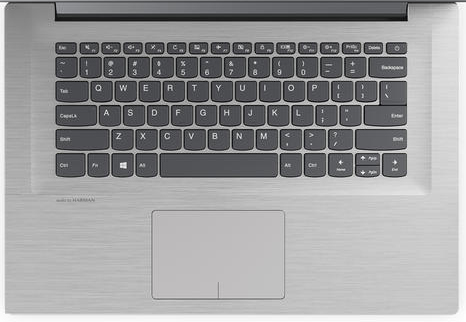
Verdict
The whole existence of the Ideapad 320s (15-inch) undermines the one of the Ideapad 320. Why? Because the Ideapad 320s does everything better for just about the same price. For roughly the same asking price, you get better battery life, better overall design and build quality (especially if you consider the thinner side bezels of the screen giving the Ideapad 320s a more modern look), more storage options, better input devices and identical hardware.
But even if you ignore the existence of the Ideapad 320, the Ideapad 320s is actually a pretty sweet deal. Its price is affordable given the features it offers – decent hardware and a Full HD IPS display. The latter needs a little polishing here and there but should do just fine for everyday tasks and web browsing. It also lacks PWM above 65 cd/m2 so it should be safe to use for long periods of time.
In addition to all of this, the Ideapad 320s impresses with solid battery life, which is rarely seen in this price range, except for the Acer Aspire 5 (A515-51G) – just a tad more expensive, yet still an excellent alternative. However, we can’t ignore the fact that the GPU reaches abnormally high temperatures under load, which may turn out to be problematic in the long run.
Pros
- Nice build
- Good input devices
- IPS panel with good contrast
- The panel doesn’t use PWM above 65 cd/m2 brightness
- Good battery life
Cons
- High inner temperatures under load, GPU reaches 91 °C
- The screen has limited sRGB coverage and low maximum brightness

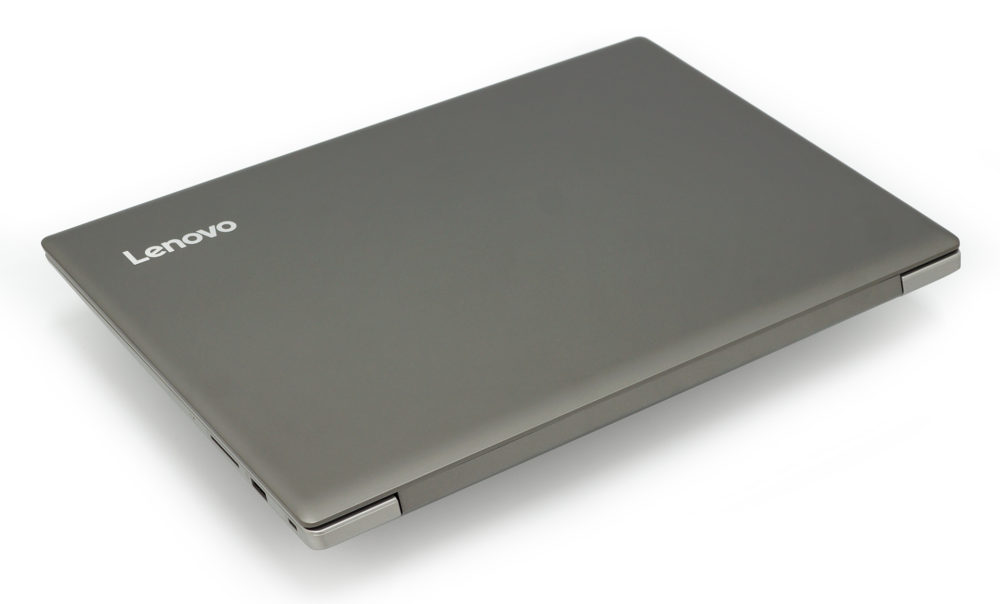
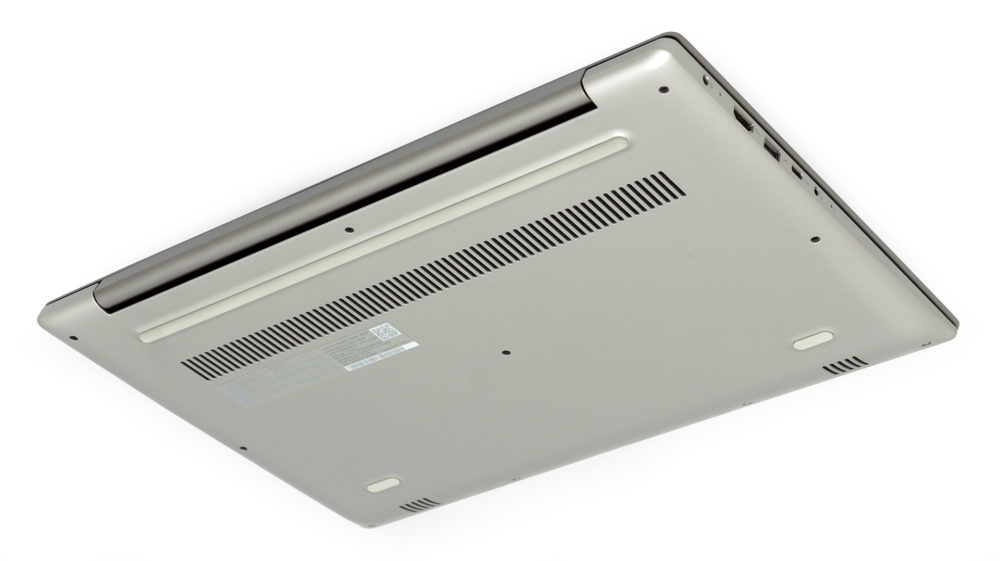




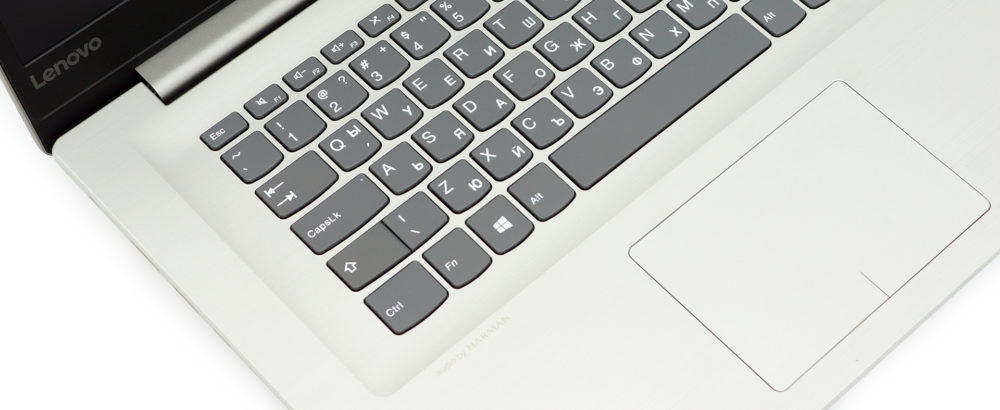
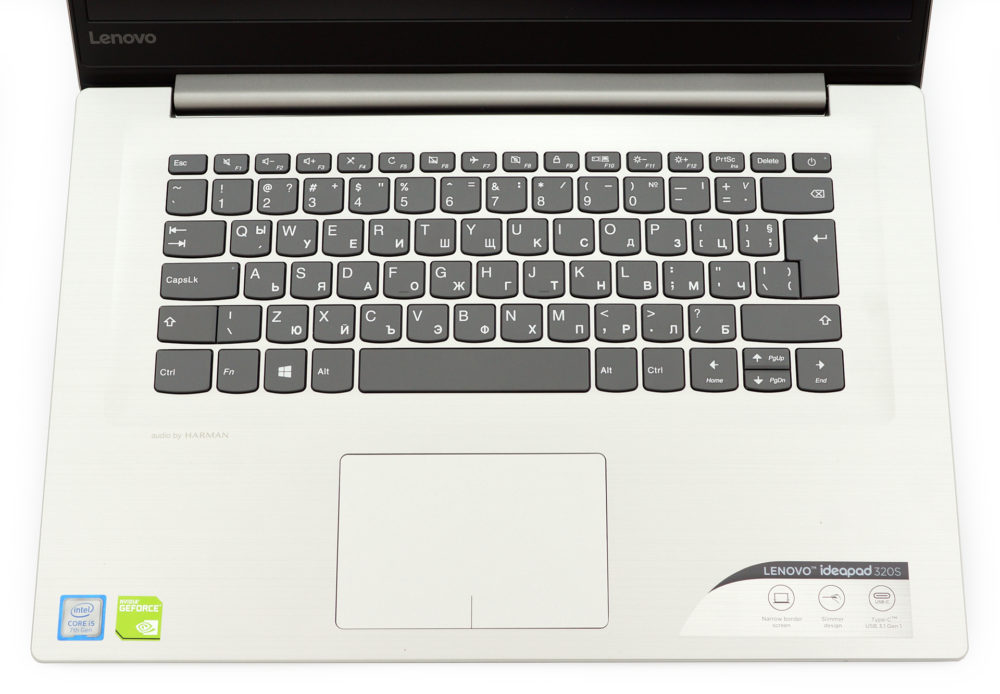
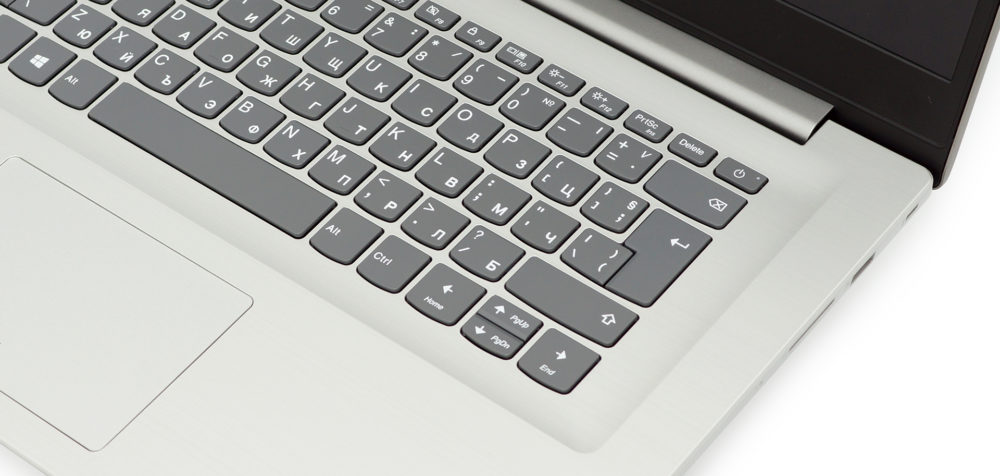
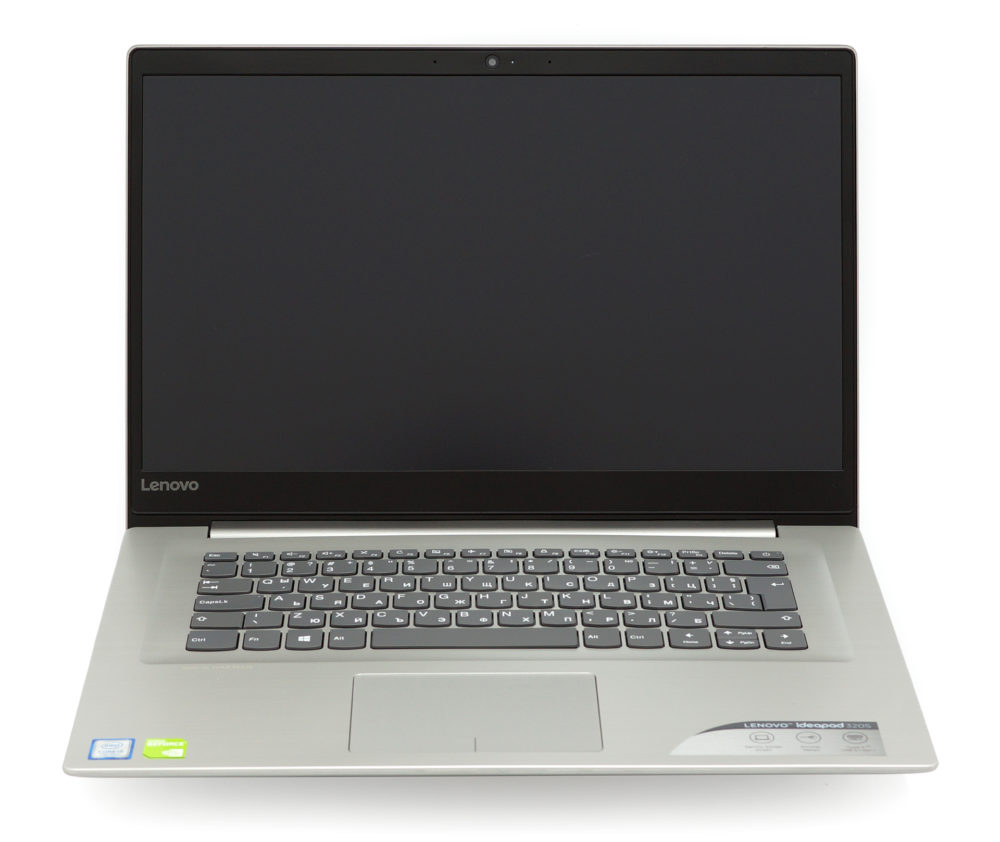

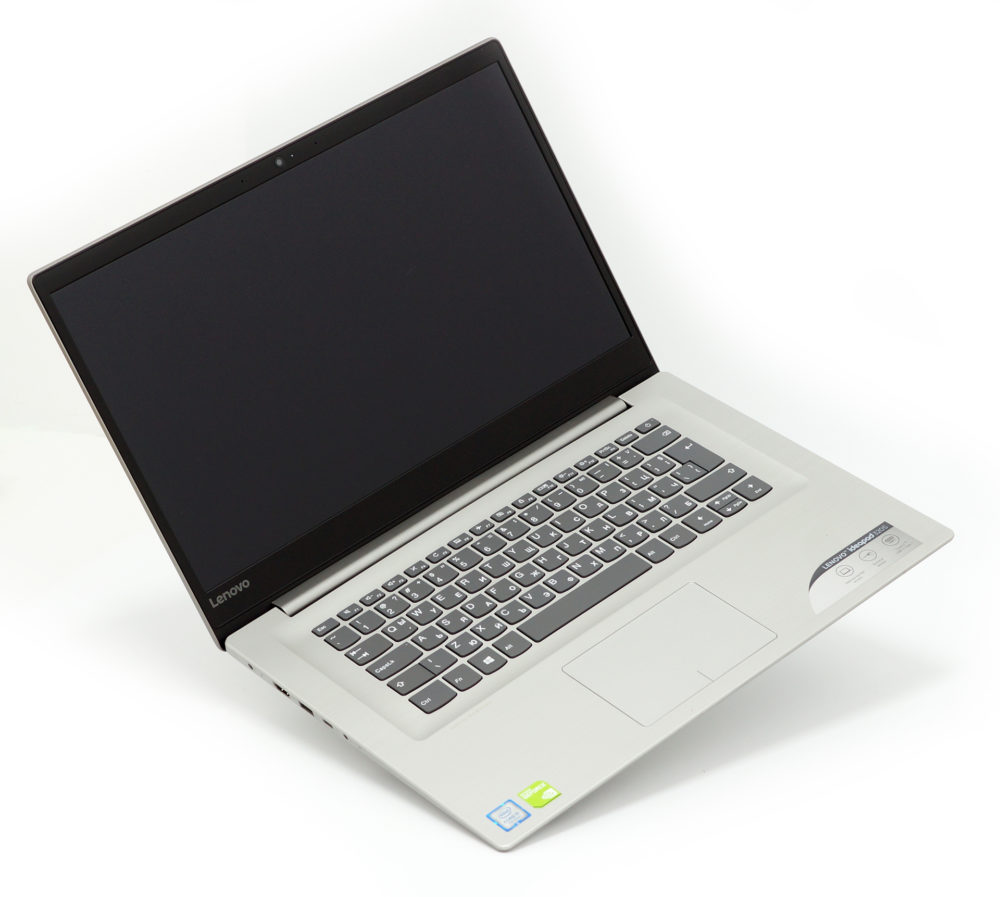






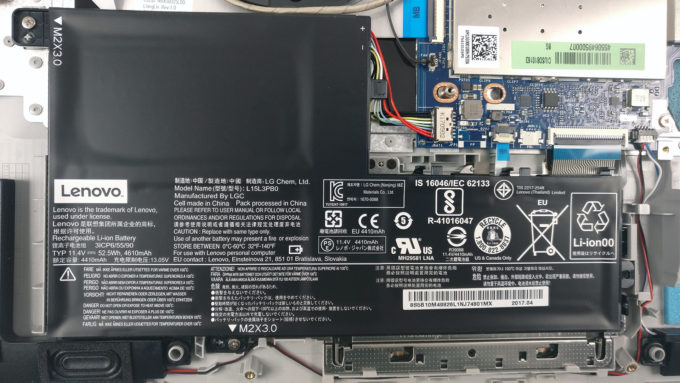




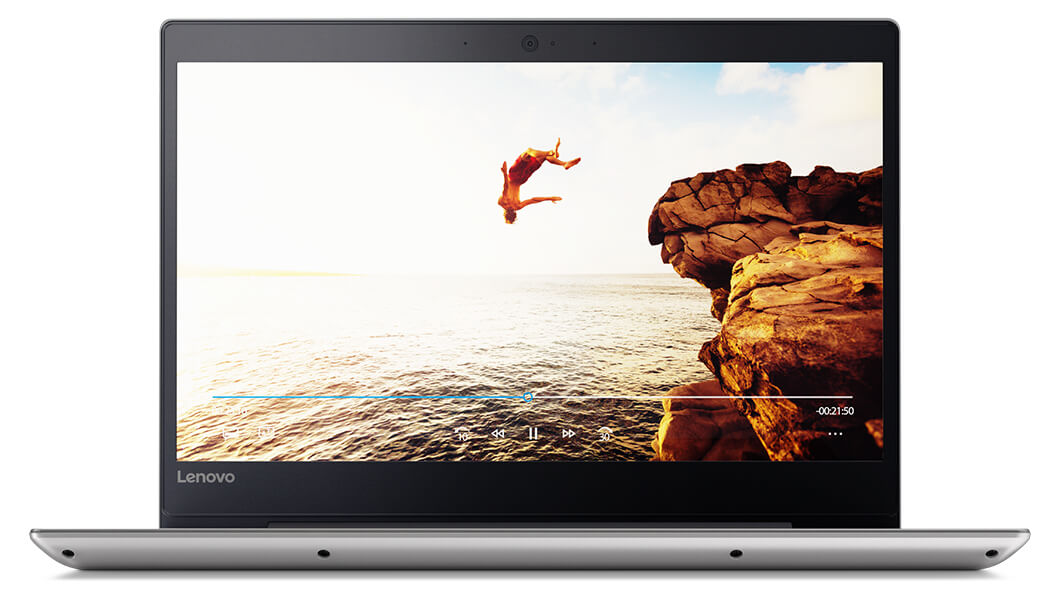

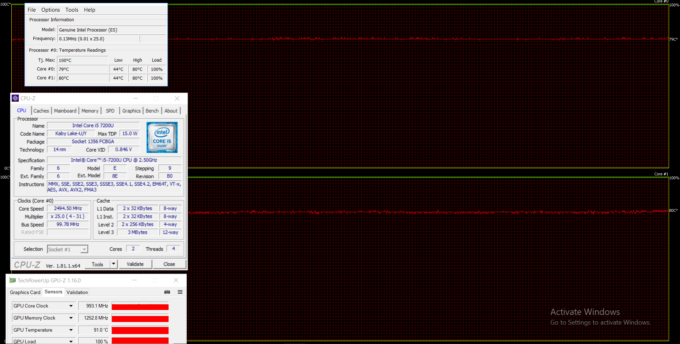








Asked to turn adblocker off so the site can make money and the first advert to pop up is ‘Buy X1 Carbon for £350’ leading to an obvious scam site. This website needs to consider its advertising partners if it wants us to take it seriously.